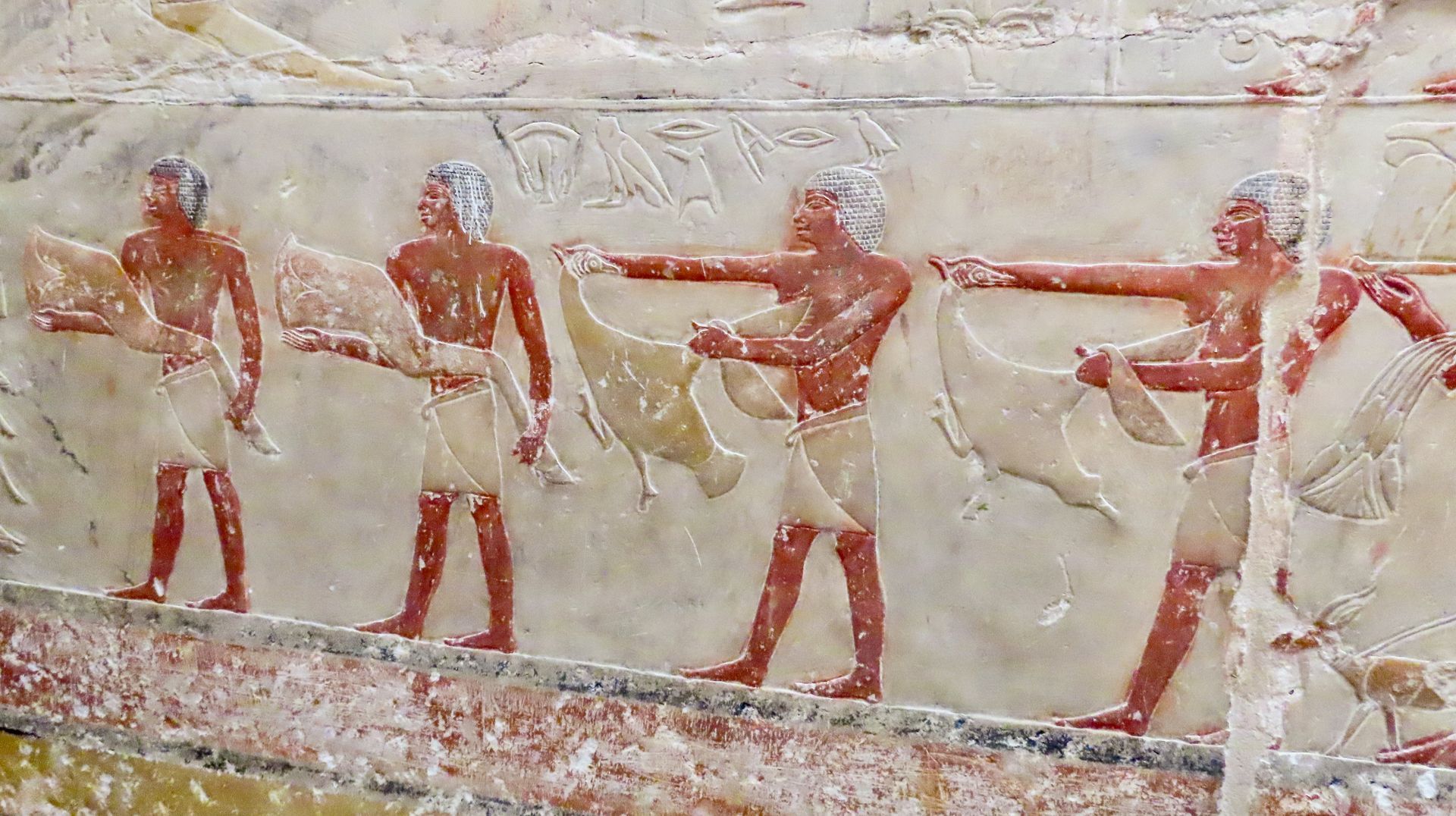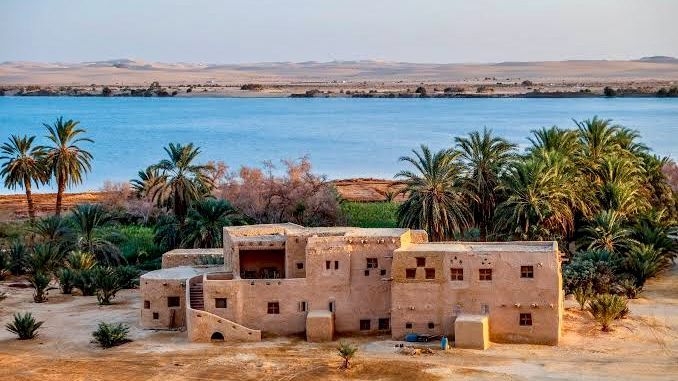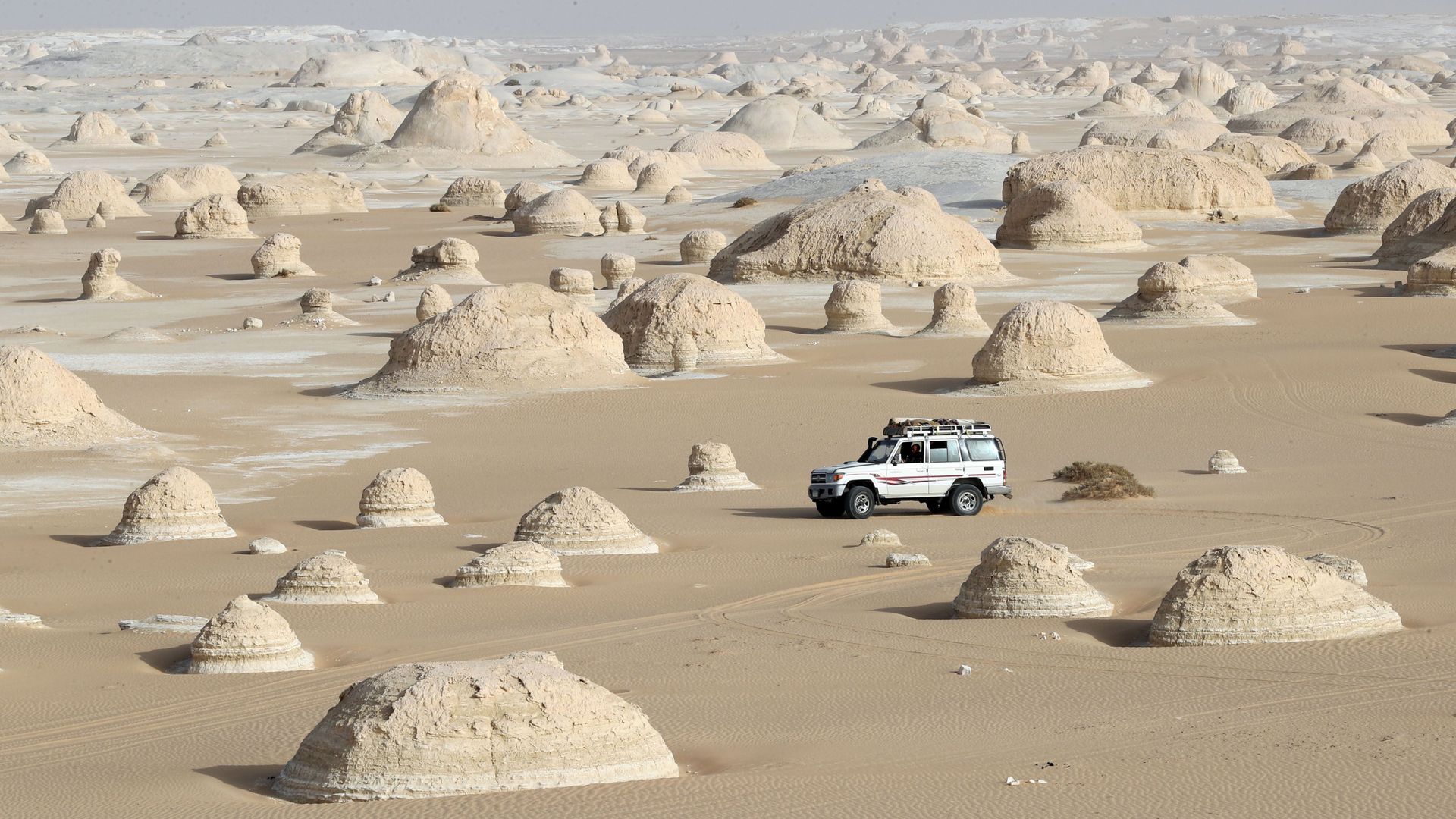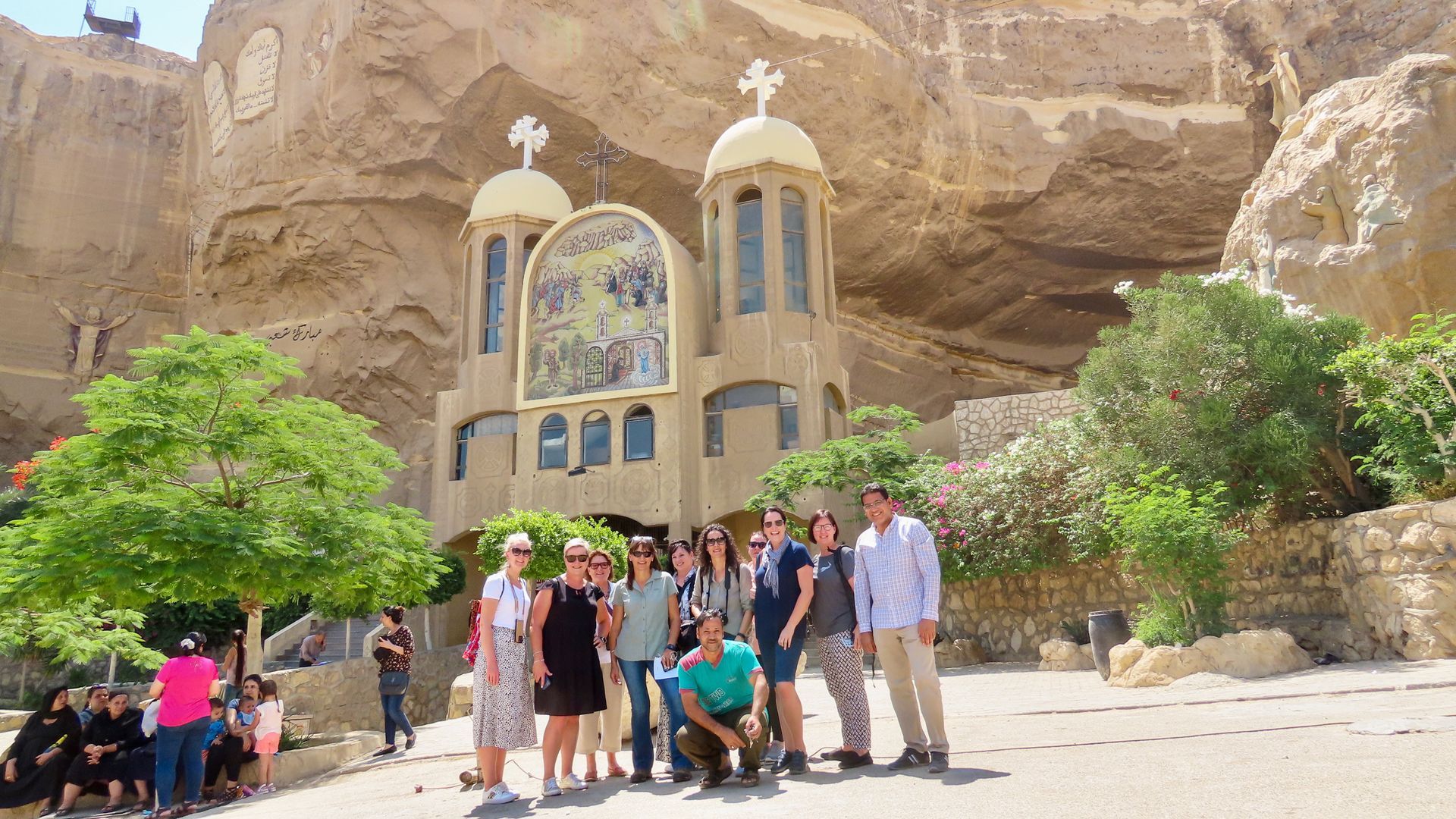Egypt Attractions & Highlights
If you are a first-time visitor to Egypt, the Pyramids of Giza, a Nile cruise, and the archaeological treasure in Luxor are a must-see. But Egypt offers many more exciting experiences. Scuba dive in the Red Sea, hike to the top of Mount Sinai or journey out into the desert and visit the oases. Egypt is more than just pyramids and temples – it is home to beautiful beaches, dunes, unique desert landscapes, pristine coral reefs and luxurious resort towns.
-
Exploring Temples
Visiting the temples of Ancient Egypt is a must on any discerning traveller’s list. From the famous Luxor Temple to the Valley of the Kings, there are many opportunities to dive deeply into Ancient Egypt’s history and culture. Listen to your Egyptologist guide as he explains the hieroglyphs carved in the walls of the temples and learn about the ancient ways this civilisation lived.
- Karnak Temple
The Karnak Temple is the second most visited site in Egypt and is considered the largest religious building ever constructed. It was a cult temple in honour of the Egyptian gods of Amun, Mut, and Khonsu. Karnak Temple is, in fact, a collection of temple buildings. Today, the remains of this vast complex include decayed temples, towers, chapels, and other buildings. Prepare to be astounded by the awe-inspiring Hypostyle Hall with its 134 gigantic columns tower 24 meters high and decorated with intricate hieroglyphics.
- Luxor Temple
Primarily built by the New Kingdom pharaohs Amenhotep III and Ramses II, this is the oldest temple in Egypt and is often referred to as “the world’s largest open-air museum.” Luxor Temple looks and feels like a smaller version of Karnak Temple, although this temple served a different purpose than many found in and around Luxor. This temple is not dedicated to one particular god or pharaoh. Instead, it may have been where many of the kings of ancient Egypt were crowned. The Luxor and Karnak temples are linked by a 3km avenue lined with sphinxes.
- Queen Hatshepsut’s Temple
Within the grounds of the Theban Necropolis stands the exquisite Temple of Hatshepsut, built in honour of the only female pharaoh to reign over Egypt as a man for over 20 years. She is considered one of the most powerful female rulers in the world. Her temple lies at the foot of dramatic rugged limestone cliffs that rise nearly 300m above the desert plain at Deir al-Bahri. The temple is instantly recognisable with its three elongated collonaded terraces connected by long ramps.
- Edfu Temple
The Temple of Horus at Edfu is the most completely preserved Egyptian temple and is the second-largest temple in Egypt. It was one of the last monumental temples built on a large scale, and though much newer than the temples of Karnak and Luxor, its excellent state of structural preservation fills in historical gaps. One of the more famous landmarks in Egypt is a complex of courts and chambers decorated with engraved walls and statues.
- Kom Ombo
The Temple of Haroeris and Sobek near the town of Kom Ombo is a highlight on any river journey. The unusual double temple is dedicated to two distinct divinities from Egyptian mythology: the crocodile-headed Sobek, the god of fertility and creator of the world, and Haroeris or the ancient falcon-headed Horus, the solar war god. Each of the two gods has its entrance, court, chambers, colonnade, and sanctuary with fine reliefs, with the left side of the temple dedicated to Haroeris and the right to Sobek. A path from the temple leads to the new Crocodile Museum, which exhibits a collection of mummified crocodiles.
- Philae Temple
The Temple of Isis, or the Philae Temple as it is commonly known, has long captivated travelers. Originally stood on the sacred island of Philae, the temple spent half the year submerged in water. The construction of the Aswan Dam threatened to submerge the temple and permanently cause irrevocable damage. So, the monument was moved to nearby Aglika Island, along with the small, ruined Temple of Hathor and the attractive Kiosk of Trajan, which features well-preserved floral columns. The architecture of the Isis temple perfectly blends Ancient Egyptian and Greco-Roman styles with sculpted pillars, tall towers, and colonnades and shows how the later rulers utilized what had gone before.
- Abu Simbel
Dating back to the 13th century BC, Abu Simbel is one of the unique tourist attractions in Egypt. Originally carved out of the mountainside, towering figures of Rameses II guard the entrances, accompanied by smaller statues of his immediate family and built by Ramses II in the 13th century BC overlooking Lake Nasser to impress his power and the Egyptian religion on his southern neighbours. The Temple of Abu Simbel features four gigantic statues of Ramses gazing out over his lands. In addition, there is a smaller temple of Ramses II’s queen – Nefertari – and it is one of the few places in Egypt where the male and female statues are the same size. Inside, scripts on the walls tell tales of Ramses II’s military victories and personal life. Interestingly, it took around 20 years to complete these gigantic statues! Rising waters threatened to swallow the temples when they built the High Dam and moved the entire temple – stone by stone – into its current position.
-
Pyramids and The Great Sphinx Of Giza
One of the Seven Wonders of the World, the Pyramids of Giza, standing on the Giza Plateau, is one of the world's most recognisable landmarks. Having awed travellers down through the ages, these tombs of the Pharaohs Cheops (Khufu), Chephren (Khafre), and Mycerinus (Menkaure), guarded by the enigmatic Sphinx, are usually top of most visitor's lists of tourist attractions to see in Egypt. The pyramids are around 4,500 years old in Egypt's Old Kingdom era.
-
Necropolis of Saqqara
Located south of Giza on the edge of the Western Desert, the necropolis of Saqqara is Egypt's largest archaeological site (occupying an area of 7 x 1.5 kilometres). Serving as the cemetery for Memphis - the ancient capital of Egypt for over 3,500 years, Saqqara was the final resting place for numerous pharaohs. These kings were buried within 11 major pyramids, the most famous of which is Zhoser's Step Pyramid. This pyramid is largely considered to be the oldest stone building complex in the world, dating back to 2630 BC.
-
Pyramids of Dahshur
Further south of Saqqara lies the royal necropolis of Dahshur, which contains some of Egypt's most impressive pyramids yet sees surprisingly fewer visitors. Dating back to the 4th and 12th dynasties, 11 pyramids once stood in Dahshur. Still, only two have withstood the test of time - the Red Pyramid, one of the very first pyramids ever built in Egypt, and the Bent Pyramid, which has remained remarkably intact. The Dashur pyramid should be on your list of adventures when going on your Egypt pyramid tour itinerary. To enter the pyramids, you will descend tight, steep tunnels and then explore the ancient chambers inside of the pyramids.
-
Memphis
Although little remains of the ancient capital, Memphis is worthy of a visit for its pivotal role in Ancient Egypt's history and for its claim to being the world's earliest imperial city. Constructed from mud-brick, Memphis has largely been reclaimed by the Nile silt with just a handful of surviving monuments, including the Colossus of Ramses II, which lies on its back in a concrete shelter, and an impressive alabaster sphinx.
-
Nile Cruise
Measuring 6,680 kilometres from end to end, the Nile is the world’s longest river. It’s also the lifeblood of Egypt, flowing through the heart of the Sahara desert. Sailing on the Nile River, past ancient tombs and temples, is one of Egypt’s top experiences. Most cruises sail between Aswan and Luxor, with visits to Esna, Edfu and Kom Ombo along the way. Nile river cruise in Egypt is a definite adventure and is one of the most popular ways to see the wealth of archaeological treasures and cultural attractions Egypt offers.
-
Hot-Air Balloon Ride Over Luxor
Start your journey on the West Banks, and soak in the stillness and serenity of the early morning hours. At dawn, around 20 balloons take off for flights of up to an hour, creating a fabulous spectacle in the sky. During this incredible journey, your pilot will fascinate you with captivating stories of Ancient Egypt.
-
Felucca Sailing
Watching the sunset over the Nile, the bankside palm trees casting shadows on the water, and the far mountains turning pink in the fading light. Ramp up the romance by taking to the river on a felucca from Luxor or Aswan. These wooden sailing boats are a common sight and have been used for millennia.
-
The Grand Egyptian Museum
The world of Egyptology is about to change for good! The Grand Egyptian Museum, Giza’s long-overdue antiquities treasure trove located adjacent to the Pyramids, is due to open in 2023 to shed new light on ancient artefacts and thousands of finds that have never been seen before. Until then, you’ll still be able to ogle the century-old Egyptian Museum on Tahrir Square in nearby Cairo, which the new archaeological temple is replacing.
-
Valley of the Kings
Ancient Egypt’s most famous royal tombs are spread across the arid Theban Hills on the Nile’s west bank near Luxor. Unlike the pharaohs of the Old Kingdom, who were buried in the north around Giza and the Nile Delta, the ruling dynasties of the New Kingdom preferred to be buried close to the ancient capital of Thebes (present-day Luxor). The Valley was the burial place for Egypt’s most important Pharaohs for over 500 years. Sightseeing in Egypt would be incomplete without a Valley of the Kings tour on your list. The burial location of various high-ranking nobles and pharaohs of the Ne Kingdom, the Valley of the Kings, contains 62 known tombs, but only a few are open to the public. Each tomb is decorated with impressive paintings and hieroglyphs. These ancient tombs are like a window into a lost world. Not far from the Valley of the Kings lies the Valley of the Queens, where the wives of pharaohs, including Queen Nefertari, were buried in 80 tombs with delicate murals to rival those found in the kings’ tombs.
-
Valley of the Queens
The Valley of the Queens was the burial site of the wives of the pharaohs. The tombs you will see here are smaller and lack some of the grandeur of the tombs in the Valley of the Kings. One significant exception is the tomb of Queen Nefertari – one of the most spectacular tombs you can visit in Egypt. The level of detail is impressive, and the colours are more vibrant than what we saw in many tombs, temples, and pyramids in Egypt. It will give you an idea of what the tombs looked like 3,000 years ago.
-
The Western Desert – Spend Time in an Oasis
The Western Desert's rugged beauty is for those who prefer to explore the adventurous side of the desert. The Western Desert holds many activities to tempt even the most reserved travelers, including camel & jeep safaris, hiking, bird watching, and fossil hunting. Visit the Valley of the Golden Mummies as well as the oasis towns.
Siwa Oasis, located in western Egypt near the Libyan border, is considered the most beautiful oasis. It is also the most remote, located 560 km from Cairo.
The Bahariya Oasis, located 330 km from Cairo, has several small ancient sites. A visit here is often combined with the White Desert.
The Fayoum Oasis is a quasi-oasis located next to the Nile River, south of Cairo. Visit Wadi El Rayan, a national park with man-made lakes and several waterfalls. You can also explore the Valley of the Whales, where you can see the skeletons of sharks, whales, and other fossils that date back millions of years.
-
Visit The White Desert, Egypt’s Alien Landscape
The White Desert is a national park in the Western Desert of Egypt. Uniquely shaped limestone rock formations decorate this desert landscape. To get here, it's a long drive from Cairo, and you need to book a guided 4×4 tour. A visit to the White Desert usually includes a quick visit to the Black Desert and the Bahariya Oasis.
-
Cairo Capital City
The capital city of Egypt, Cairo, is an ideal place for people who love history because it still has classic features of the ancient Egypt civilisation in almost every corner of this city. The Egyptian Museum is the jewel in the crown. It is a treasure trove overflowing with ancient Egyptian artefacts. You can enter the world-famous Royal Mummy room for a small additional fee.
-
Coptic Cairo
Coptic Cairo is located in Old Cairo in the southern part of the city. The first settlements here date back to the 6th century BC. Many of the places to visit here originate from Egypt’s Christian past. The top places to visit in Coptic Cairo include the Hanging Church, the Church of St. Sergius and Bacchus, the Ben Ezra Synagogue, and the Mosque of Amr Ibn al-As.
-
Relax in Sharm El-Sheikh
The Red Sea is one of the world’s most incredible dive locations — and the good news is that it’s accessible even to beginners. Sharm el-Sheikh is well set up for novices, with plenty of operators offering PADI courses over several days. Get comfortable with the equipment in the pool; once you’re confident, you’ll be taken out with a divemaster to scuba dive over the reefs, gliding amongst clownfish and rays. If you already know what you’re doing, plenty of outfitters will take you to the best dive sites, including Ras Mohammed, one of Egypt’s national parks. There are multiple snorkelling opportunities too.
Sharm El Sheikh tours is what you need if you only want to chill out on the beach or take a break from the tombs and temples. This is a great place to add to your travel itinerary. The top things to do at the Red Sea include scuba diving, visiting the Ras Mohammed National Park, shopping in the Sharm Old Market, and relaxing in Naama Bay and Shark’s Bay.
-
Hike to the Summit of Mount Sinai
Walk in the footsteps of Moses. According to the Old Testament, Moses received the Ten Commandments from God on the summit of Mount Sinai on the Sinai Peninsula. Known in Arabic as Jabal Musa, the mountain is a suitably biblical sight and climbing it is a properly religious experience. For maximum atmosphere, go up at night under a star-filled sky, stopping to drink coffee from Bedouin stalls; on your Mount Sinai tour you’ll be at the top for the sunrise — watching the peaks of the surrounding mountains turn red in the morning light is a truly epic moment. On the way back down, stop at UNESCO-listed St Catherine’s Monastery; built around AD330, it’s the oldest functioning monastery in the world. There are two paths to the summit, the easier and wider Camel Path and the shorter, more challenging Steps of Penitence. The hike is a 6.40 km round trip. Most hikers/visitors stay in either Dahab or Sharm El Sheikh.
-
Take a Food Tour of Cairo - Bellies En-Route
One of the best ways to get to the heart of a country and its culture is its cuisine. That’s certainly the view of the two local women who run Bellies En-Route, with two tempting food walking tours in Cairo — one a more general introduction, the other on the city’s street food. You’ll learn how falafel is made and be introduced to the history and culture of certain Egyptian dishes, including ful medames (mashed fava beans), koshari (a mix of lentils, rice, onions, chickpeas and tomato sauce) and thick Egyptian coffee, all the while tucking into samples and making friends along the way.
-
Visit Alexandria
Located on the Mediterranean Sea, Alexandria is the second largest city in Egypt and is also known as “The Pearl of the Mediterranean”. Take a day trip to Alexandria (only 225 kilometres from Cairo), founded by Alexander the Great more than 2,000 years ago. It was once the country’s centre of culture and learning, home to an ancient library and the Lighthouse of Pharos, both are now gone. There is a new library to explore, the Citadel of Qaitbay, the Alexandria National Museum, the Serapeum, the Corniche, the Stanley Bridge, the Catacombs of Kom El Shoqafa, and Montazah Palace Gardens.
Egypt Tours
LUXURY EGYPT GROUP TOUR
GROUP TOUR
8 days/ 7 nights
Highlights: Cairo / Nile River Cruise / Luxor / Aswan / Abu Simbel
Date: 18 - 15 November '25
TASTE OF EGYPT GROUP TOUR
8 days / 7 nights
Highlights: Cairo / Nile River Cruise / Luxor / Aswan / Abu Simbel
Date: Private Tour
DISCOVER EGYPT TOUR
10 days/ 9 nights
Highlights: Cairo, Nile River Cruise / Luxor / Aswan / Abu Simbel / Alexandria
Date: Private Tour











































